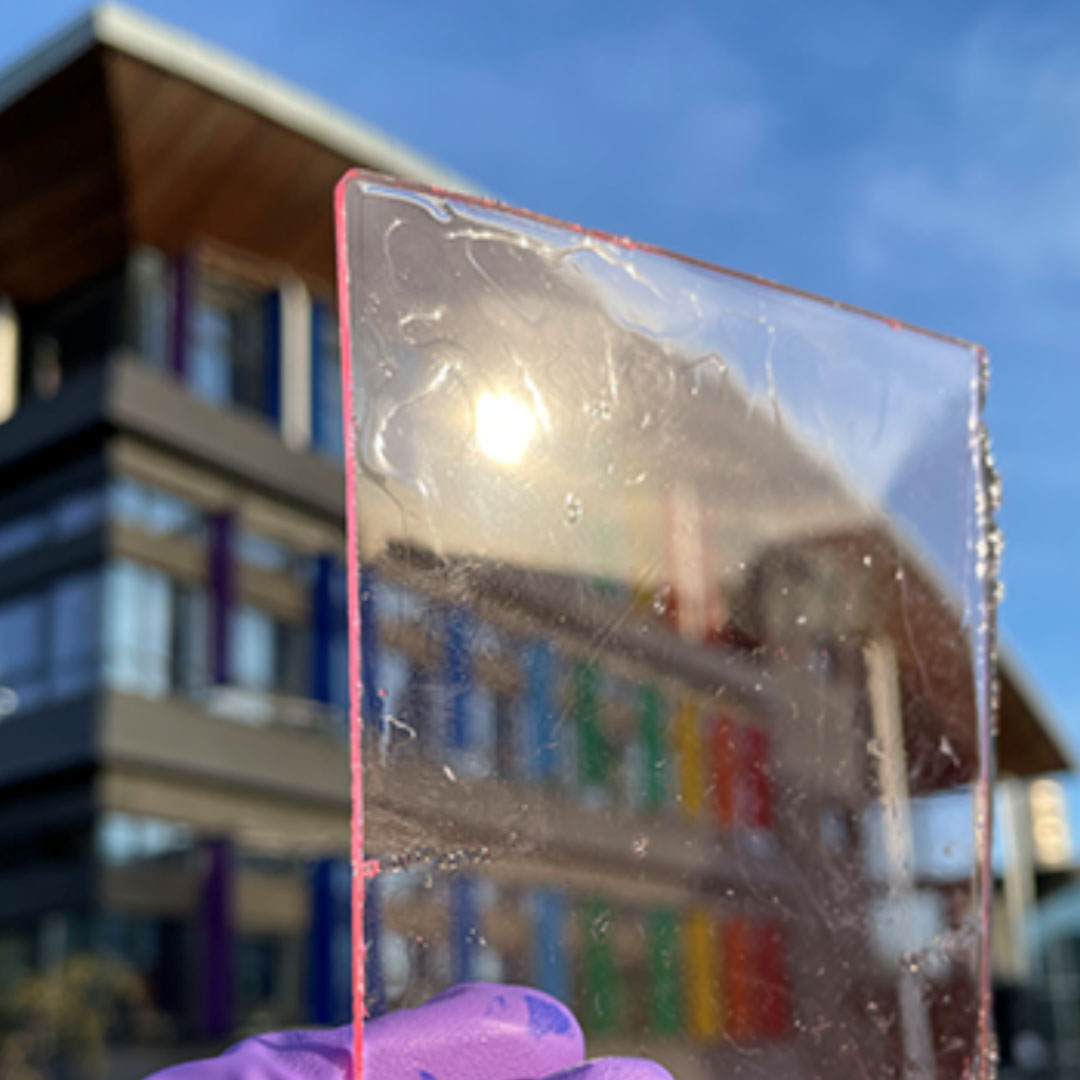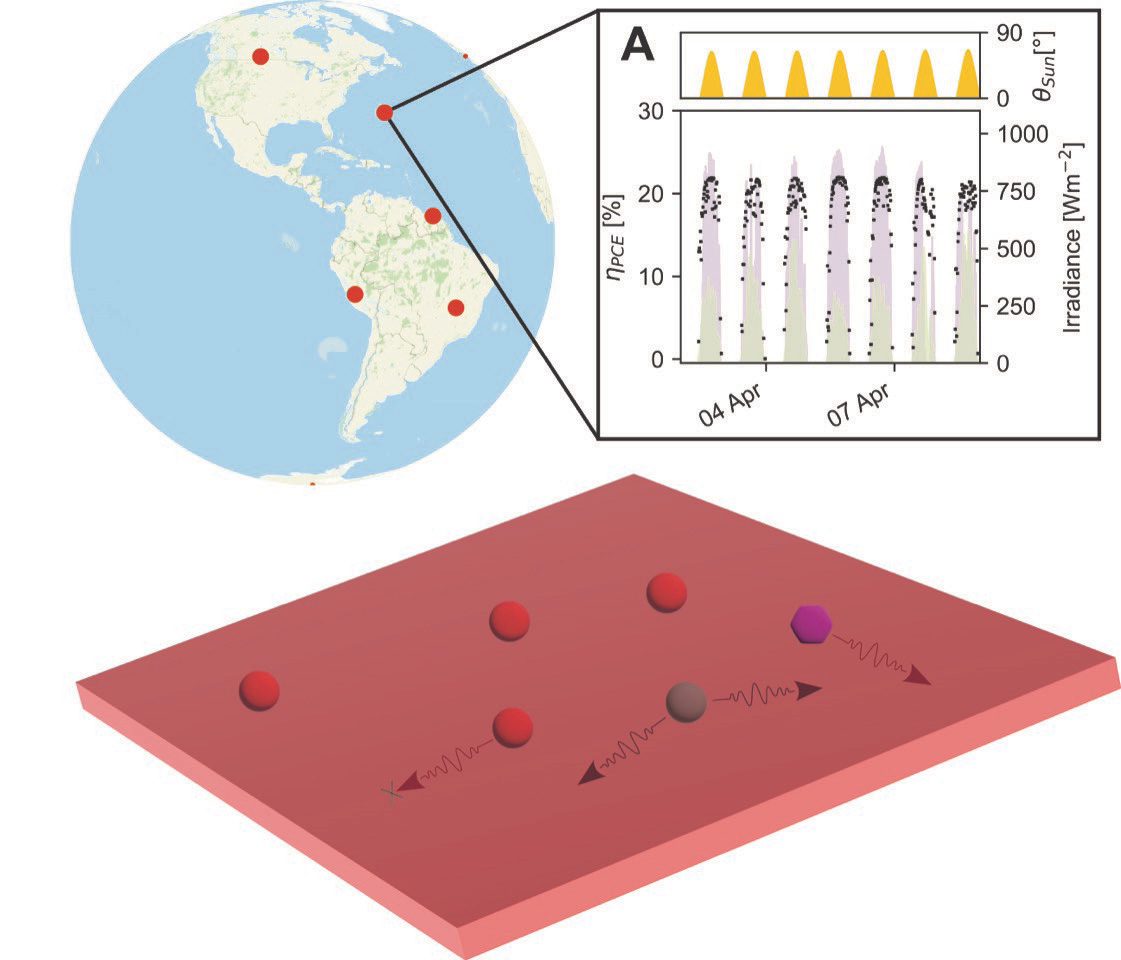A semi-transparent luminescent solar concentrator. [Image: T. Baikie, Cavendish Laboratory, University of Cambridge]
Luminescent solar concentrators (LSCs), the devices underlying many forms of “smart windows,” hold a tantalizing potential. The semi-transparent LSCs’ core competencies—concentrating solar energy and shunting light of exactly the right wavelength to strips of photovoltaic (PV) cells in their edges—should, in principle, give them a place in future sustainable-energy plans. But how well can today’s LSC designs actually perform in the real world, and how much better can they realistically get?
A research team at the University of Cambridge, UK, and the Institute for Atomic and Molecular Physics (AMOLF), Netherlands, has now done the math—and the result is a mixed picture for LSCs (Joule, doi: 10.1016/j.joule.2024.01.018). In the two localities it studied in detail across an entire year, the team concludes, even “the best imaginable LSC technologies” are unlikely to outperform the workhorse of solar energy collection, traditional silicon solar cells, in power efficiency. Yet, as costs for LSCs continue to be driven down, their adaptability to a variety of local situations and economies—as well as tricks such tiling or “tessellating” the concentrators to optimize output—still could make them “an exciting avenue for the future of solar energy capture.”
Concentrating and channeling sunlight
LSCs are essentially thin, semi-transparent panes of plastic or glass that are doped with chromophores, such as fluorophores or quantum dots. The chromophores in the LSC absorb ambient solar energy and re-emit it at a more narrowly defined wavelength band. The window then acts as a waveguide, channeling the re-emitted light to strips of PV cells at the edge of the LSC pane, which harvest the concentrated light and convert it to electricity.
In principle, LSCs have a number of attractions.
In principle, LSCs have a number of attractions. They should be able to concentrate light better than conventional lens-based solar concentration schemes, as they can grab diffuse daylight and let the embedded chromophores do the heavy lifting of wavelength conversion and concentration. And, with the right choice of chromophores, the LSCs can tune the re-emitted light to the optimal wavelength band for feeding the PV cells at their edges.
LSCs constitute one technology direction that’s been considered for so-called smart windows, which generate electricity in addition to other benefits. Another use case for LSCs could be stand-alone LSC solar panels, which are not intended for use as windows and thus can beef up their light-concentrating mojo with nontransparent add-ons such as back-reflecting mirrors.
Modeling LSCs in the real world
The research team modeled the efficiency of luminescent solar concentrators—which include chromophores that re-emit and concentrate solar photons for conversion to electricity—at various locations worldwide. [Image: T. Baikie, Cavendish Laboratory, University of Cambridge]
The researchers behind the new work wanted to find out how well current LSC technology would perform in specific settings around the world. To do so, they began by taking detailed angle-resolved spectral measurements of incoming sunlight in two localities—Boulder, CO (USA), and Amsterdam (Netherlands)—across a full calendar year. The team then benchmarked those readings against data from the World Bank Group’s Global Solar Atlas database to model how the spectral and irradiance data from these locations might be extrapolated to other worldwide sites.
Next, the group used the Boulder and Amsterdam data as input in ray-tracing simulations to determine the photon paths at different angles of incidence within different LSC designs for each locality. Using those simulations, the researchers then calculated the potential efficiencies both for the best existing LSC designs and for LSCs embodying potential future improvements.
Such improvements, according to the authors, might include the use of highly optimized quantum dots as chromophores (instead of the fluorescent dyes used in most current LSC designs), as well as “photomultiplier” chromophores that convert each higher-energy incident photon into two lower-energy ones. The team also looked at the impact of technologies—such as back-reflectors, distributed Bragg reflectors and directionally emitting chromophores—that can maximize the number of converted photons that find their way to the PV strips at the LSC’s edges.
A piece of the puzzle
Pulling all of the data together and integrating it across an entire year, the team found that in terms of power-conversion efficiency (PCE), even the most optimized LSC designs fell short of the efficiency of silicon PVs of the same area—the most convenient benchmark for comparison. That is perhaps not terribly surprising, given the differences in the technologies and their potential use cases. The authors point out, in particular, that for smart-window LSCs, the relevant comparison is not with an energy-producing silicon PV, but with a passive, semi-transparent window that produces no energy at all. There, LSCs clearly shine.
The researchers found that even the best LSC designs fall short of silicon PVs in power-conversion efficiency (PCE). But they also stress that PCE comparisons aren’t the whole story.
Also, the authors stress that PCE comparisons aren’t the whole story. In the real world, cost also comes into play—and the researchers believe that if the lifetime costs of quantum-dot-enabled LSC systems can be brought down to less than 50% of those of traditional PV panels, the LSC technology might prove “a viable option in many parts of the world.” That could be particularly true, the authors say, for lightweight polymer LSCs, which could be easier to install and more resistant to shading than other varieties.
Tweaking the installation parameters of LSCs could also boost their capabilities, the authors suggest. For example, installing LSCs on the side of a building in a “tessellated” (tiled) configuration, in which semi-transparent window LSCs alternate with the best opaque directional LSC panels, more than doubles the power output that might be expected from the window alone.
In sum, the authors believe their study suggests that, while LSCs fall short of silicon PVs in a head-to-head comparison, they still have great potential for the future energy mix. Realizing that potential, though, will require looking beyond improving the devices’ PCE, and focusing instead on the right combination of creative design and low cost for a given area. “It’s like a puzzle pattern,” the study’s first author, Tomi Baikie at Cambridge, said in a press release, “that could help us capture even more sun power.”


